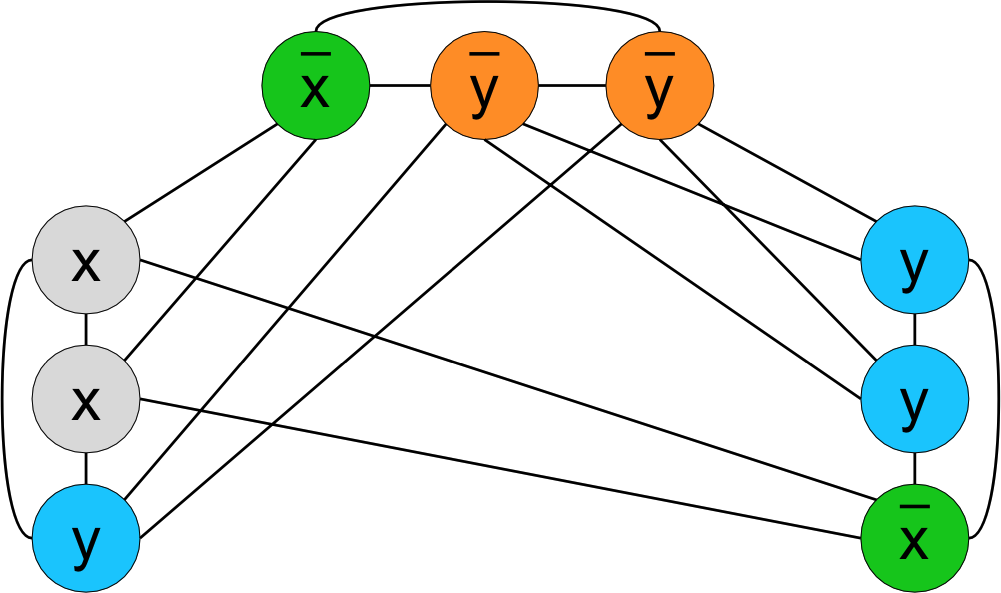Title
Recall: definition of Polynomial-Time Reducibility
Let \(A, B \subseteq \binary^*\) be decision problems. We say \(A\) is polynomial-time reducible to \(B\)
if there is a polynomial-time computable function \(f\) such that for all \(x \in \binary^*\):
\[ x \in A \iff f(x) \in B \]
We denote this by \(A \le^P B\).
\(A \le^P B\) means: “B is at least as hard as A” (to within a polynomial-time factor).
- If \(A \le^P B\) and \(B \in \P\) then \(A \in \P\).
- If \(A \le^P B\) and \(A \notin \P\) then \(B \notin \P\).
Recall: Reductions Between Problems of Different Types
Theorem: \(\probThreeSAT \le^P \probIndSet\).
Proof:
Given a 3-CNF formula \(\phi\): \[ \phi = (a_1 \lor b_1 \lor c_1) \land (a_2 \lor b_2 \lor c_2) \land \ldots \land (a_k \lor b_k \lor c_k) \] we produce a pair \((G, k)\) such that: \[ \encoding{\phi} \in \probThreeSAT \; \iff \; \encoding{G, k} \in \probIndSet \]
Set \(k\) equal to the number of clauses in \(\phi\).
Create one node in \(G\) for each literal in \(\phi\).
Create edge {u, v} in \(G\) if and only if:
- \(u\) and \(v\) correspond to literals in the same clause (triple), or
- \(u\) is labeled \(x\) and \(v\) is labeled \(\overline{x}\) for some variable \(x\) (or vice versa).

Reductions Don’t Themselves Solve Problems!

- A reduction \(f\) is just a (polynomial-time) algorithm
- It enables solving problem \(A\) in terms of an algorithm for problem \(B\).
- However, \(f\) does not itself solve either problem!
- It transforms an instance of problem \(A\) (e.g., a formula for \(\probThreeSAT\))
into an instance of problem \(B\) (e.g., a graph for \(\probIndSet\)). - It preserves the “yes” or “no” answer to the original problem
(but does not provide the answer itself).
- It transforms an instance of problem \(A\) (e.g., a formula for \(\probThreeSAT\))
NP-Hardness and NP-Completeness
A language \(B\) is called NP-hard if for every language \(A \in \NP\), \(A \le^P B\).
A language \(B\) is called NP-complete if:
- \(B \in \NP\); and
- \(B\) is NP-hard.
Theorem: If \(B\) is NP-complete and if \(B \in \P\) then \(\P = \NP\).
Proof:
- Assume that \(B\) is NP-complete and \(B \in \P\).
- We know \(\P \subseteq \NP\) and just need to show \(\NP \subseteq \P\).
- We do this by showing that for any \(A \in \NP\), we have \(A \in \P\).
- Since \(B\) is NP-hard, we have \(A \le^P B\).
- Then according to this theorem, \(A \in \P\). ✅
NP-Hardness and NP-Completeness
A language \(B\) is called NP-hard if for every language \(A \in \NP\), \(A \le^P B\).
A language \(B\) is called NP-complete if:
- \(B \in \NP\); and
- \(B\) is NP-hard.
Theorem: If \(B\) is NP-complete and if \(B \in \P\) then \(\P = \NP\).
Corollary: If \(\P \ne \NP\) then no NP-complete problem is in \(\P\).
This is the significance of NP-completeness:
if you show your problem is NP-hard, then there is (probably) no efficient algorithm for it.
Transitive Property of Polynomial-Time Reducibility
We can chain reductions together!
Observation: \(\le^P\) is transitive
(if \(A \le^P B\) and \(B \le^P C\), then \(A \le^P C\))
def reduce_A_to_B(x):
"""
reduction from NP prob
A to NP-hard prob B
"""
raise NotImplementedError()def reduce_B_to_C(x):
"""
reduction from B
to NP-hard prob C
"""
raise NotImplementedError()def C_decider(x):
"""
hypothetical polynomial-time
decider
"""
raise NotImplementedError()def A_decider(x):
"""
polynomial time
"""
y = reduce_A_to_B(x)
z = reduce_B_to_C(y)
return C_decider(z)\(A\) will be a stand-in for any problem in \(\NP\).
Transitive Property of Polynomial-Time Reducibility
Theorem: If \(B\) is \(\NP\)-hard and \(B \le^P C\) for some language \(C\),
then \(C\) is also \(\NP\)-hard.
Proof:
- Let \(A \in \NP\).
- Since \(B\) is \(\NP\)-hard, \(A \le^P B\).
- Since \(\le^P\) is transitive, \(A \le^P C\).
- Therefore \(C\) is \(\NP\)-hard.
Corollary: If \(B\) is \(\NP\)-complete, \(B \le^P C\),
and \(C \in \NP\), then \(C\) is \(\NP\)-complete.
Finding a reduction from any known-NP-hard problem \(B\) to \(C\) proves that all problems in \(\NP\) are reducible to \(C\)! (\(C\) is NP-hard too.)
Restatement of the Cook-Levin Theorem
Cook-Levin Theorem: \(\probSAT\) and \(\probThreeSAT\) are NP-complete.
- Proof: Optional Section 10.10 (and ECS 220)
- This is proved “directly” by exhibiting a reduction from a generic problem \(A \in \NP.\)
- Once we have these “base” NP-complete problems, we can build up a library of
NP-complete problems by finding reductions from other problems.
Theorem: \(\probIndSet\) and \(\probClique\) are NP-complete.
Proof:
- \(\probThreeSAT \le^P \probIndSet\) as proved earlier, so \(\probIndSet\) is NP-hard.
- \(\probIndSet \le^P \probClique\) as proved earlier, so \(\probClique\) is NP-hard.
- \(\probClique, \probIndSet \in \NP\) due to polynomial-time verifiers (shown for \(\probClique\) here).
- Thus, both \(\probIndSet\) and \(\probClique\) are NP-complete.